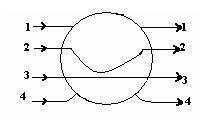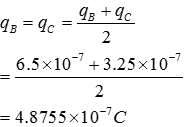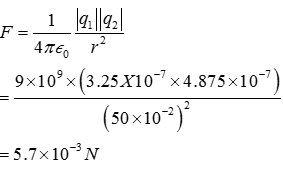Electric Charges and Fields - Online Test
Q1. A tennis ball which has been covered with charges is suspended by a thread so that it hangs between two metal plates. One plate is earthed, while other is attracted to a high voltage generator. The ball
Answer : Option C
Explaination / Solution:
The plate which connected to high voltage generator induces negative charge on ball which causes attraction. When the ball strikes the positive plate, charge distribution again takes place that is the bass becomes positive and repulsion takes place. When it strikes the plate which connected to earth than its charge goes to earth and again it will be attracted towards positive plate. Hence the ball swings backward and forward hitting each plate in turn.
Q2. A metallic solid sphere is placed in a uniform electric field. In the figure, which path will the lines of force follow?

Answer : Option D
Explaination / Solution:
The electric field is always perpendicular to the surface of a conductor. On the surface of a metallic solid sphere, the electrical field is oriented normally (i.e. directed towards the centre of the sphere).so 4th line is correct.
Q3. Eight dipoles of charges of magnitude e are placed inside a cube. The total electric flux coming out of the cube will be
Answer : Option C
Explaination / Solution:
On all the dipoles net charge=0 so theotal electric flux coming out of the surface
Q4. A charge q is placed at the center of the line joining two equal charges Q. The system of the three charges will be in equilibrium if q is equal to
Answer : Option D
Explaination / Solution:

Suppose in the following figure, equilibrium of charge B is considered. Hence for it's equilibrium

Suppose in the following figure, equilibrium of charge B is considered. Hence for it's equilibrium
Q5. Four point charges qA=2μC,qB=−5μC,qC=2μC,andqD=−5μC are located at the corners of a square ABCD of side 10 cm. Force on a charge of 1μC placed at the centre of the square is
Answer : Option C
Explaination / Solution:

EB-ED=0 and so the net electric field at centre=0 so force on charge 1µC=0

EB-ED=0 and so the net electric field at centre=0 so force on charge 1µC=0
Q6.
A system has two charges and located at points A: (0, 0, –15 cm) and B: (0,0, +15 cm), respectively. What are the total charge and electric dipole moment of the system?
Answer : Option C
Explaination / Solution:
Total charge=
Dipole moment=
Dipole moment=
Q7. An electric dipole with dipole moment m is aligned at with the direction of a uniform electric field of magnitude .Calculate the magnitude of the torque acting on the dipole.
Answer : Option A
Explaination / Solution:
τ=pESinθ=4×10−9×5×104Sin300=1×10−4Nm
Q8. Two insulated charged copper spheres A and B have their centres separated by a distance of 50 cm and have identical sizes. A third sphere of the same size but uncharged is brought in contact with the first, then brought in contact with the second, and finally removed from both. What is the new force of repulsion between A and B?
Answer : Option C
Explaination / Solution:
If A and B having charge each and a third sphere C having charge=0 If C is in contact with A than new charge on A and C Now C is put in contact with B so new charge on C and B

Now new charge on A is and on B is and distance =50 cm So


Now new charge on A is and on B is and distance =50 cm So

Q9. Two insulated charged copper spheres A and B have their centres separated by a distance of 50 cm. What is the mutual force of electrostatic repulsion if the charge on each is The radii of A and B are negligible compared to the distance of separation.
Answer : Option B
Explaination / Solution:


Q10. Consider a uniform electric field (a) What is the flux of this field through a square of 10 cm on a side whose plane is parallel to the yz plane? (b) What is the flux through the same square if the normal to its plane makes a angle with the x-axis?
Answer : Option D
Explaination / Solution:
(a) Electric field intensity, = 3 × î N/C Magnitude of electric field intensity, = N/C Side of the square, s = 10 cm = 0.1 m Area of the square, A = = 0.01 The plane of the square is parallel to the y-z plane. Hence, angle between the unit vector normal to the plane and electric field, = 0° Flux (Φ) through the plane is given by the relation, ϕ = =3 × × 0.01 × cos0° = 30 N
